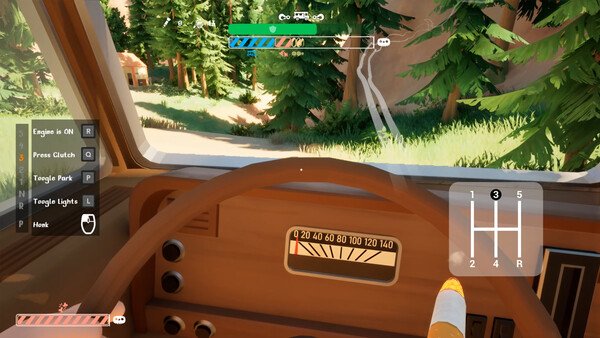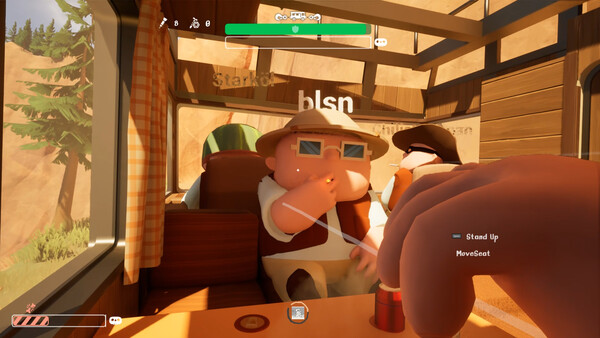Introduction
When you fire up RV There Yet?, you’re signing up for a wild road-trip where everything that can go wrong might just do so—and usually at hilarious or epic proportions. This isn’t just about driving a motorhome: it’s about coordinating a team of four, each with a vital role. Neglect any one position and the whole journey can crumble. In this article, we’ll break down the four key crew positions—Driver, Winch Operator, Mechanic, Quartermaster and walk you through how to master each one for maximum success.

The Navigator and Wheelman (The Driver)
The Driver is arguably the highest-pressure role in the entire operation. While the other RV There Yet? characters are focused on immediate emergencies, the Driver’s responsibility is the long-term strategic movement of the entire team.
Responsibilities of the Driver
The Driver’s tasks go far beyond simply holding the ‘forward’ button. They must constantly manage momentum, gear shifts, and coordinate with the exterior crew.
- Vehicle Control: RV There Yet? features surprisingly nuanced driving physics, including a clutch and gears. The Driver must be adept at using low gears for climbing steep Mabutts Valley terrain and maintaining a steady speed to prevent the RV from rolling.
- Strategic Stopping: An expert Driver knows when not to drive. If the Winch Operator needs time to find a secure anchor, or if the Mechanic needs to step out and quickly change a tire, the Driver must stop and hold the brake flawlessly.
- Winch Coordination: In the tightest spots, the Driver must apply precise throttle input to assist the Winch Operator. The teamwork here is crucial: too much power and the winch cable snaps; too little, and the RV slides backward.
Expert Tip for the Driver: Always communicate your gear and speed. Use short, clear phrases like “Going to second gear, be ready for the pull,” or “Stopping completely, Mechanic is out.”
The Engineer and Lifeline (The Winch Operator)
The Winch Operator is the physics master, the one person with the power to single-handedly correct a game-ending mistake. They are the de facto team leader when the RV is stuck or facing a major structural obstacle.
Mastering Physics with the Winch
The “RV There Yet? winch operator” uses the RV’s dual winches (front and rear) to perform physics-based rescues. This role requires patience, a keen eye for terrain, and spatial awareness.
- Anchor Point Selection: The most vital skill is choosing a strong anchor point—a large tree, a massive rock, or a stable piece of infrastructure. Attaching the winch to a small rock or a flimsy piece of wood will only result in a frustrating snap.
- The Remote Commander: The winch itself becomes a remote tool, allowing the operator to act as a tether, pull the RV out of ditches, or even use the winch to hoist themselves and the RV up impossible cliff faces.
- Obstacle Clearing: This player often uses their exterior position to scout the path ahead, tossing aside small environmental obstacles or setting up makeshift bridges using planks found at checkpoints.
The Winch Operator should always be the first person out of the vehicle and the last one back in, ensuring the RV is stabilized before the journey continues. They carry the burden of the vehicle’s successful navigation.
The Scavenger and Savior (The Mechanic)
The Mechanic is the primary health manager for the star of the show: the RV. The chaotic terrain and impacts from hazards like the rampaging bear will constantly chip away at the vehicle’s structural integrity.
Keeping the RV’s Character Intact
The RV’s well-being is displayed through several segmented health bars, covering its frame, engine, and tires. Maintaining these is the core of RV There Yet? survival.
- Scrap Metal Economy: The Mechanic is responsible for efficiently collecting and using scrap metal found at supply shacks. They must prioritize repairs: a damaged frame can lead to critical component failure, while a flat tire will immediately cripple the Driver’s control.
- Engine & Tire Maintenance: Beyond frame repair, the Mechanic must swiftly change tires and add oil to the engine when gauges drop. Ignoring these tasks will dramatically slow your progress and increase the risk of a total breakdown.
- Interior Maintenance: This player often helps with tasks inside the RV that affect its structural stability, such as patching holes or securing loose cargo before a difficult maneuver.
An effective Mechanic keeps their inventory organized and is always ready to jump out and slap a patch on the RV as soon as the Driver calls for a stop.
The Morale Manager (The Quartermaster)
In a co-op survival game where your characters can suffer from various negative status effects, the Quartermaster ensures the crew stays functional, fed, and alive. This is the RV There Yet? resource management expert, the lifeline for the players themselves.
Inventory, Health, and Status Management
The Quartermaster’s domain is the RV’s interior, focusing on the inventory and immediate crew health.
- Master Chef: The crew needs food to survive, primarily burgers made from grilling frozen meat patties found along the route. The Quartermaster must efficiently manage the grill space and ensure a steady supply of cooked food.
- Medical Response: This player carries and administers life-saving items. They are the ones who deploy antidotes to cure poison or, most critically, use the EpiPens to revive a downed crewmate before the respawn timer expires.
- Consumable Management: The Quartermaster tracks and manages consumables that apply temporary buffs and debuffs. While some players might choose to indulge in items that induce drunkenness or provide a temporary speed boost, the Quartermaster must ensure these are used strategically and not to the detriment of the overall mission.
While the other three roles focus on the RV, the Quartermaster’s expertise guarantees the longevity of the individual RV There Yet? characters.
The Art of the Swap: Dynamic Teamwork and Communication
The roles described above are not rigid classes; they are dynamic responsibilities that must fluidly change based on the immediate crisis. A true master crew is constantly swapping roles.
The Ultimate Teamwork Skill: Proximity Voice Chat
The only thing more essential than the winch is communication. RV There Yet? utilizes proximity chat, which means you can only clearly hear those physically close to you in the game. This creates the hilarious, frantic dynamic that makes the game a hit:
- The Mechanic outside the RV might be shouting wildly, but the Driver won’t hear them unless they get close enough to the window.
- The Quartermaster inside might frantically yell about needing more burgers, only to have their voice fade as the RV teeters over a cliff.
Clear, concise communication is the glue that prevents a disastrous outcome. A simple rule: when things go wrong, everyone should immediately state what resource they need (“Need scrap!”) or what they are doing (“On the winch!”).
Combining Roles for Smaller Crews
While four players is the sweet spot, you can play with fewer. If your team is smaller (2 or 3 players), you must strategically combine the most critical roles:
| Crew Size | Essential Role 1 | Essential Role 2 | Essential Role 3 |
| Two Players | Driver/Mechanic (The most reliable person) | Winch Operator/Quartermaster (The most agile person) | N/A |
| Three Players | Driver | Winch Operator/Mechanic (Exterior Focus) | Quartermaster (Interior Focus) |
Conclusion
RV There Yet? is a game that perfectly encapsulates the chaotic energy of a road trip gone wrong. It’s not about finding the perfect skill tree or leveling up your avatar; it’s about how four customizable RV There Yet? characters work together under intense pressure.
By establishing who is driving, who has the winch, who is patching the frame, and who is flipping the burgers, you transform your session from a guaranteed crash course into a surprisingly effective, albeit still hilarious, co-op survival mission. Master these four key positions, and you’ll not only survive Mabutts Valley—you’ll earn the right to put that silly hat on with pride.

